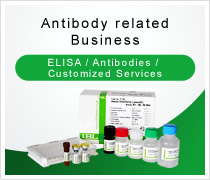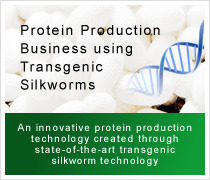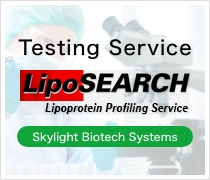- HOME >
- Frequently Asked Questions (FAQ) >
- Product related FAQ >
- FAQ Antibody - IBL
Product related FAQ
Note: Please click product codes or arrows located right hand side of each FAQ box to open and close FAQ. Please click a product name for checking the product details.
Display the Number of Items
Antibody - IBL ()
-
 Q.Which isoform can be detected by this antibody?
Q.Which isoform can be detected by this antibody? -
 A.It does react to both intact and cleaved isoform (E41) of α2, 6-Sialyltransferase.
A.It does react to both intact and cleaved isoform (E41) of α2, 6-Sialyltransferase.
-
 Q.Which Tob is detected by this antibody?
Q.Which Tob is detected by this antibody? -
 A.The antibody both phosphorylated and non-phosphorylated Tob1 detects.
A.The antibody both phosphorylated and non-phosphorylated Tob1 detects. -
 Q.What is the molecular size of Tob1?
Q.What is the molecular size of Tob1? -
 A.As the amino acid sequence of Tob1 is 345 a.a, it is approx. 38kDa based on the calculation.
A.As the amino acid sequence of Tob1 is 345 a.a, it is approx. 38kDa based on the calculation.
The molecular size of phosphorylated Tob1 is bigger than non-phosphorylated and the size is suggested as around 45kDa - 50kDa.
-
 Q.What is the epitope?
Q.What is the epitope? -
 A.It is SVVYGLR.
A.It is SVVYGLR.
-
 Q.What is the epitope?
Q.What is the epitope? -
 A.It is KSKKFRRPDIQYPDATDE.
A.It is KSKKFRRPDIQYPDATDE.
-
 Q.What is immunogen sequence for this antibody?
Q.What is immunogen sequence for this antibody? -
 A.It is TVELAELGPLLEEKGKRV.
A.It is TVELAELGPLLEEKGKRV.
-
 Q.Can human or rat sample be used for this antibody?
Q.Can human or rat sample be used for this antibody? -
 A.No, it cannot.
A.No, it cannot.
-
 Q.Which VEGF isoforms does this antibody detect?
Q.Which VEGF isoforms does this antibody detect? -
 A.It detects VEGF165 and VEGF121.
A.It detects VEGF165 and VEGF121.
-
 Q.What is immunogen sequence for this antibody?
Q.What is immunogen sequence for this antibody? -
 A.It is GVVIA.
A.It is GVVIA.
-
 Q.Can this antibody be used for human T cell?
Q.Can this antibody be used for human T cell? -
 A.Yes, it can. This antibody was used in the following publication. Please refer to it.
A.Yes, it can. This antibody was used in the following publication. Please refer to it.
Requirements for the functional expression of OX40 ligand on human activated CD4+ and CD8+ T cells.
Kondo K et al. Hum Immunol. 2007 Jul;68(7):563-71. Epub 2007 Apr 13.
-
 Q.Can this antibody be used for human T cell?
Q.Can this antibody be used for human T cell? -
 A.Yes, it can.
A.Yes, it can.
-
 Q.Why the antibody cannot be used as neutralizing antibody?
Q.Why the antibody cannot be used as neutralizing antibody? -
 A.As the catalog product contains BSA and NaN3, the antibody cannot be used as neutralizing antibody.
A.As the catalog product contains BSA and NaN3, the antibody cannot be used as neutralizing antibody.
However, if we specifically produce the antibody as customized product without BSA and NaN3 and sterilization for filling process in frozen, it can be used as neutralizing antibody.
Please feel free to contact us if you are interested in the customized antibody.
-
 Q.Can this antibody use for IHC as secondary antibody?
Q.Can this antibody use for IHC as secondary antibody? -
 A.No, it cannot be recommended for the use. A biotinized antibody is recommended to use for the purpose.
A.No, it cannot be recommended for the use. A biotinized antibody is recommended to use for the purpose.
-
 Q.How do you biotinylation the antibody?
Q.How do you biotinylation the antibody? -
 A.NHS-LC-Biotin is used for the biotinylation.
A.NHS-LC-Biotin is used for the biotinylation. -
 Q.What is subclass and light chain?
Q.What is subclass and light chain? -
 A.The subclass is Rat IgG1. The light chain is lambda.
A.The subclass is Rat IgG1. The light chain is lambda.
-
 Q.How do you biotinylation the antibody?
Q.How do you biotinylation the antibody? -
 A.NHS-LC-Biotin is used for the biotinylation.
A.NHS-LC-Biotin is used for the biotinylation.
-
 Q.Does the antibody cross react to mice?
Q.Does the antibody cross react to mice? -
 A.No, it doesn't.
A.No, it doesn't.
-
 Q.Does this antibody react to any APP isoform?
Q.Does this antibody react to any APP isoform? -
 A.As the antibody specifically reacts N-terminal of Amyloidβ, it does not react to APP, Aβ(2-40) and Aβ(3-40).
A.As the antibody specifically reacts N-terminal of Amyloidβ, it does not react to APP, Aβ(2-40) and Aβ(3-40). -
 Q.How do you biotinylation the antibody?
Q.How do you biotinylation the antibody? -
 A.NHS-LC-Biotin is used for the biotinylation.
A.NHS-LC-Biotin is used for the biotinylation.
-
 Q.Does this antibody react to any APP isoform?
Q.Does this antibody react to any APP isoform? -
 A.As the antibody specifically reacts N-terminal of Amyloidβ, it does not react to APP, Aβ(2-40) and Aβ(3-40).
A.As the antibody specifically reacts N-terminal of Amyloidβ, it does not react to APP, Aβ(2-40) and Aβ(3-40).
-
 Q.What is the recommended concentration of this antibody for use?
Q.What is the recommended concentration of this antibody for use? -
 A.It is 100μg/mL.
A.It is 100μg/mL. -
 Q.I am considering to conduct immunohistochemistry. How many prepalates can be stained with 100ug?
Q.I am considering to conduct immunohistochemistry. How many prepalates can be stained with 100ug? -
 A.KM55 is 100ug/1mL.
A.KM55 is 100ug/1mL.
Usually, 0.1-0.2mL/preparate is used. This means 5-10 prepalates can be stained. -
 Q.I am struggling for staining using this antibody. Can you recommend any method for IHC?
Q.I am struggling for staining using this antibody. Can you recommend any method for IHC? -
 A.Please refer to the method written in this article.
A.Please refer to the method written in this article. -
 Q.How much is approx. normal IgA in blood?
Q.How much is approx. normal IgA in blood? -
 A.Total IgA is approx 1-4mg/mL in blood.
A.Total IgA is approx 1-4mg/mL in blood. -
 Q.How much is approx. normal Gd-IgA in blood?
Q.How much is approx. normal Gd-IgA in blood? -
 A.As it is approx 1,000 ng/mL in blood, more than 200 fold dilution is recommended for measurement.
A.As it is approx 1,000 ng/mL in blood, more than 200 fold dilution is recommended for measurement. -
 Q.Where the antibody (Anti-Gd-IgA1(KM55) rat IgG) recognize?
Q.Where the antibody (Anti-Gd-IgA1(KM55) rat IgG) recognize? -

-
 Q.According to the data sheet of the antibody (KM55), immunogen activation treatment is required when performing immunohistochemical staining (IHC) using KM55 with formalin fixed paraffin embedded tissues.
Q.According to the data sheet of the antibody (KM55), immunogen activation treatment is required when performing immunohistochemical staining (IHC) using KM55 with formalin fixed paraffin embedded tissues.
Why is the treatment required? -
 A.The targeted antigen might be masked by the fixation process in immunohistochemical staining.
A.The targeted antigen might be masked by the fixation process in immunohistochemical staining.
For avoiding such masking effects, immunogen activation (enzymatic treatment or heat treatment) is required for exposing the targeted antigen.
Subtilisin A treatment is recommended for IHC using the antibody (KM55).
-
 Q.Can this antibody be used for mice lysate?
Q.Can this antibody be used for mice lysate? -
 A.The antigen, GST-TobN that is used in the article is fusion protein of N-terminal 168 amino acids of Tob protein and GST.
A.The antigen, GST-TobN that is used in the article is fusion protein of N-terminal 168 amino acids of Tob protein and GST.
The sequence of this region is same between human and mouse.
Therefore, theoretically it would be possible to detect using by the antibody #18911 with mice sample but as we have not tested, we cannot be certain about the point.
-
 Q.What species of monkey is used for absorbing this product?
Q.What species of monkey is used for absorbing this product? -
 A.The crab-eating macaque (cynomolgus monkey).
A.The crab-eating macaque (cynomolgus monkey).
-
 Q.Does this antibody cross react to mouse samples?
Q.Does this antibody cross react to mouse samples? -
 A.Cross reactivity with mouse samples is not so strong when it's compared with human samples. But we have confirmed this antibody detects mouse sAPPα.
A.Cross reactivity with mouse samples is not so strong when it's compared with human samples. But we have confirmed this antibody detects mouse sAPPα.
-
 Q.What positive controls are used for this antibody?
Q.What positive controls are used for this antibody? -
 A.Recombinant 27A and 27B (lysates of transfectant cell) are used as the positive control.
A.Recombinant 27A and 27B (lysates of transfectant cell) are used as the positive control.
-
 Q.What is the epitope?
Q.What is the epitope? -
 A.The position is between 65 and 120 of amino acid sequences of human Galectin-3.
A.The position is between 65 and 120 of amino acid sequences of human Galectin-3.
-
 Q.What is the epitope?
Q.What is the epitope? -
 A.The position is between 65 and 120 of amino acid sequences of human Galectin-3.
A.The position is between 65 and 120 of amino acid sequences of human Galectin-3.
-
 Q.What region of the protein is recognized?
Q.What region of the protein is recognized? -
 A.The antibody recognizes the region contains arginine located at position 112 of amino acid sequences of human ApoE4.
A.The antibody recognizes the region contains arginine located at position 112 of amino acid sequences of human ApoE4.
-
 Q.Is endogenic peroxidase treatment required for fluorescence stain?
Q.Is endogenic peroxidase treatment required for fluorescence stain? -
 A.No, it is not required.
A.No, it is not required. -
 Q.Regarding formic acid treatment, is inactivation treatment by citric acid autoclave required?
Q.Regarding formic acid treatment, is inactivation treatment by citric acid autoclave required? -
 A.No, inactivation treatment by citric acid autoclave is not required. However, we recommend formic acid treatment (after deparaffinization, leave it in formic acid for 5 to 30 minutes and wash it by running water.) if you use brain tissue.
A.No, inactivation treatment by citric acid autoclave is not required. However, we recommend formic acid treatment (after deparaffinization, leave it in formic acid for 5 to 30 minutes and wash it by running water.) if you use brain tissue.
-
 Q.Can it be used for IHC for mouse and rat samples? What kind of positive control was used for?
Q.Can it be used for IHC for mouse and rat samples? What kind of positive control was used for? -
 A.Yes, it can. We use human lung adenocarcinoma and human stomach cancer tissues for positive control.
A.Yes, it can. We use human lung adenocarcinoma and human stomach cancer tissues for positive control.
-
 Q.It seems like this antibody can detect apotosis cells, but does it also positively react to other stage of cells such as mitotic period phase cells or ischemia-induced dead cells?
Q.It seems like this antibody can detect apotosis cells, but does it also positively react to other stage of cells such as mitotic period phase cells or ischemia-induced dead cells? -
 A.We consider that it does only detect apotosis cells due to its specificity.
A.We consider that it does only detect apotosis cells due to its specificity.
-
 Q.What is the sequence of the antigen or where is the region?
Q.What is the sequence of the antigen or where is the region? -
 A.The sequence is IPVKQADSGSSEEKQ. The region is N-terminal of full length of Osteopontin.
A.The sequence is IPVKQADSGSSEEKQ. The region is N-terminal of full length of Osteopontin. -
 Q.Does this antibody detect full length Osteopontin or Osteopontin cleaved by Thrombin? If the antibody detects Osteopontin cleaved by Thrombin, which part of cleaved Osteopontin is detected by this antibody?
Q.Does this antibody detect full length Osteopontin or Osteopontin cleaved by Thrombin? If the antibody detects Osteopontin cleaved by Thrombin, which part of cleaved Osteopontin is detected by this antibody? -
 A.As the region of the antigen is N-terminal of full length Osteopontin, the antibody detects both full length Osteopontion and N-terminal Osteopontin cleaved by Thrombin. This antibody does not detect to C-terminal Osteopontin cleaved by Thrombin.
A.As the region of the antigen is N-terminal of full length Osteopontin, the antibody detects both full length Osteopontion and N-terminal Osteopontin cleaved by Thrombin. This antibody does not detect to C-terminal Osteopontin cleaved by Thrombin. -
 Q.What is the epitope?
Q.What is the epitope? -
 A.It is IPVKQADSGSSEEKQ.
A.It is IPVKQADSGSSEEKQ.
-
 Q.What can be used for positive control?
Q.What can be used for positive control? -
 A.Cancer cellline such as NB-1 can be used as the positive control.
A.Cancer cellline such as NB-1 can be used as the positive control.
-
 Q.What can be used for positive control?
Q.What can be used for positive control? -
 A.Cancer cellline such as NB-1 can be used as the positive control.
A.Cancer cellline such as NB-1 can be used as the positive control.
-
 Q.What is the condition of dilution when it is used for IHC?
Q.What is the condition of dilution when it is used for IHC? -
 A.Recommended concentartion for use is 5μg/mL. Please dilute reconstituted 1mL (100μg/mL) 20 folds for use.
A.Recommended concentartion for use is 5μg/mL. Please dilute reconstituted 1mL (100μg/mL) 20 folds for use.
-
 Q.Can this antibody be used on human or mice samples?
Q.Can this antibody be used on human or mice samples? -
 A.It has not been tested.
A.It has not been tested.
-
 Q.What species of monkey is used for absorbing this product?
Q.What species of monkey is used for absorbing this product? -
 A.The crab-eating macaque (cynomolgus monkey).
A.The crab-eating macaque (cynomolgus monkey). -
 Q.How do you biotinylation the antibody?
Q.How do you biotinylation the antibody? -
 A.NHS-LC-Biotin is used for the biotinylation.
A.NHS-LC-Biotin is used for the biotinylation.
-
 Q.Can this antibody be used on mice or rat samples ?
Q.Can this antibody be used on mice or rat samples ? -
 A.No it cannot.
A.No it cannot. -
 Q.Does the antibody cross react to mice?
Q.Does the antibody cross react to mice? -
 A.No, it doesn't.
A.No, it doesn't.
-
 Q.Can this antibody be used to stain the paraffin section?
Q.Can this antibody be used to stain the paraffin section? -
 A.No, it cannot be used to stain this section.
A.No, it cannot be used to stain this section. -
 Q.Can this antibody use for rat samples?
Q.Can this antibody use for rat samples? -
 A.As only one amino-acid is different between mouse and rat, so it would be able to use for rat but we cannot be certain for it. Unfortunately, we do not have any experiences nor data for rat sample wit hte antibody.
A.As only one amino-acid is different between mouse and rat, so it would be able to use for rat but we cannot be certain for it. Unfortunately, we do not have any experiences nor data for rat sample wit hte antibody. -
 Q.Does it cross react to human Claudin-6?
Q.Does it cross react to human Claudin-6? -
 A.Yes, it does due to the sequence is same between mouse and human. SRGPSEYPTKNYV
A.Yes, it does due to the sequence is same between mouse and human. SRGPSEYPTKNYV
-
 Q.Can this antibody stain frozen sections?
Q.Can this antibody stain frozen sections? -
 A.No it cannot.
A.No it cannot.
-
 Q.Which APP types can be detected by this antibody?
Q.Which APP types can be detected by this antibody? -
 A.This antibody can detect any isoform of APP.
A.This antibody can detect any isoform of APP.
-
 Q.Can this antibody be used on mice samples ?
Q.Can this antibody be used on mice samples ? -
 A.No, it cannot.
A.No, it cannot.
-
 Q.Which region can this antibody recognize?
Q.Which region can this antibody recognize? -
 A.The extracellular domain.
A.The extracellular domain. -
 Q.Can this antibody stain frozen sections?
Q.Can this antibody stain frozen sections? -
 A.Yes it can.
A.Yes it can. -
 Q.Can this antibody be used on mice samples?
Q.Can this antibody be used on mice samples? -
 A.No it cannot.
A.No it cannot.
-
 Q.Can this antibody be used on mice samples ?
Q.Can this antibody be used on mice samples ? -
 A.No, it cannot.
A.No, it cannot.
-
 Q.Can this antibody be used for FACS?
Q.Can this antibody be used for FACS? -
 A.No, it cannot.
A.No, it cannot.
-
 Q.Can this antibody be used on mice samples ?
Q.Can this antibody be used on mice samples ? -
 A.Yes, it can.
A.Yes, it can.
-
 Q.Can this antibody be used on mice or rat samples ?
Q.Can this antibody be used on mice or rat samples ? -
 A.No, they cannot.
A.No, they cannot.
-
 Q.Which immunizing antigen is used?
Q.Which immunizing antigen is used? -
 A.A fragment of the N terminal of Nephrin (amino-acid 22-240) is used as the antigen.
A.A fragment of the N terminal of Nephrin (amino-acid 22-240) is used as the antigen.
-
 Q.Can this antibody be used for staining?
Q.Can this antibody be used for staining? -
 A.No it cannot.
A.No it cannot.
-
 Q.Can this antibody be used on mice samples ?
Q.Can this antibody be used on mice samples ? -
 A.No, it cannot.
A.No, it cannot.
-
 Q.Can this antibody be used for staining?
Q.Can this antibody be used for staining? -
 A.No it cannot.
A.No it cannot.
-
 Q.What is the molecule size?
Q.What is the molecule size? -
 A.Approximately 52kDa.
A.Approximately 52kDa.
-
 Q.Can this antibody detect full length of APP or sAPPα?
Q.Can this antibody detect full length of APP or sAPPα? -
 A.This antibody cannot react with the full length of APP or sAPPα when performing evaluations with WB. However, because we have only conducted evaluations with WB, we cannot be 100% certain about the cross reactivity with sAPPα and full-length APP. That is why we made the following statement on our datasheet: "This antibody can detect the sAPP-Wild type, which is cleaved by β-secretase. It exhibits very little cross-reaction with sAPPα and full-length APP."
A.This antibody cannot react with the full length of APP or sAPPα when performing evaluations with WB. However, because we have only conducted evaluations with WB, we cannot be 100% certain about the cross reactivity with sAPPα and full-length APP. That is why we made the following statement on our datasheet: "This antibody can detect the sAPP-Wild type, which is cleaved by β-secretase. It exhibits very little cross-reaction with sAPPα and full-length APP."
-
 Q.Can this antibody be used on mice samples ?
Q.Can this antibody be used on mice samples ? -
 A.No, it cannot.
A.No, it cannot.
-
 Q.Can this antibody be used on mice or rat samples ?
Q.Can this antibody be used on mice or rat samples ? -
 A.No, it cannot.
A.No, it cannot.
-
 Q.Can this antibody be used on mice or rat samples ?
Q.Can this antibody be used on mice or rat samples ? -
 A.No, it cannot.
A.No, it cannot.
-
 Q.Which VEGF type does this antibody react to?
Q.Which VEGF type does this antibody react to? -
 A.The antibody reacts to 165, 189, and 206.
A.The antibody reacts to 165, 189, and 206. -
 Q.Can this antibody be used on mice or rat samples ?
Q.Can this antibody be used on mice or rat samples ? -
 A.yes, it can.
A.yes, it can.
-
 Q.Can this antibody be used on mice samples ?
Q.Can this antibody be used on mice samples ? -
 A.No, it cannot.
A.No, it cannot.
-
 Q.Where does the W.B. band appear?
Q.Where does the W.B. band appear? -
 A.ET-AR appears around 48kDa, and ET-BR appears around 50kDa.
A.ET-AR appears around 48kDa, and ET-BR appears around 50kDa.
-
 Q.Can this antibody be used on rat samples ?
Q.Can this antibody be used on rat samples ? -
 A.No it cannot.
A.No it cannot.
-
 Q.Can this antibody detect the thrombin-cleaved type of Osteopontin?
Q.Can this antibody detect the thrombin-cleaved type of Osteopontin? -
 A.The thrombin-cleaved C-half can be detected, but the N-half cannot.
A.The thrombin-cleaved C-half can be detected, but the N-half cannot.
-
 Q.Does this antibody react with full-length of APP?
Q.Does this antibody react with full-length of APP? -
 A.No, it doesn’t.
A.No, it doesn’t. -
 Q.Does this antibody react with wild type of APP?
Q.Does this antibody react with wild type of APP? -
 A.No, it doesn't.
A.No, it doesn't.

















